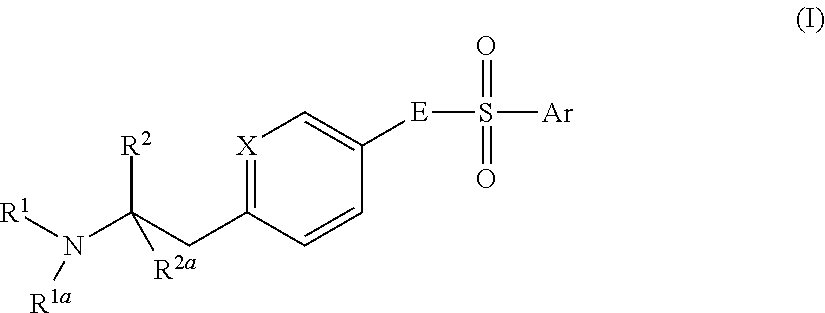Aminoethylaromatic compounds suitable for treating disorders that respond to modulation of the dopamine D3 receptor
a technology of aminoethylaromatic compounds and receptors, which is applied in the field of aminoethylaromatic compounds, can solve the problems of their affinity for dsub>3 /sub>receptors or their pharmacological profile is not satisfactory
- Summary
- Abstract
- Description
- Claims
- Application Information
AI Technical Summary
Problems solved by technology
Method used
Image
Examples
preparation examples
I. Preparation of Intermediates
a. Preparation of 2-Aminopropylphenylamines
a. 1 4-((S)-2-Amino-propyl)-phenylamine×HCl
[0197]A mixture of 4-nitrophenylacetone (5 g, 27.91 mmol), (S)-(−)-α-phenylethylamine (3.4 g, 28.06 mmol), and platin(IV) oxide (100 mg) in methanol (MeOH) (50 ml) was hydrogenated at atmospheric pressure for a period of 8 h. After filtration and evaporation of the solvent under reduced pressure 4-[(S)-2-((S)-1-phenyl-ethylamino)-propyl]-phenylamine was obtained as a yellow oil 6.7 g, 94%). Without further purification a solution of this oil in methanol (100 ml) together with ammonium formate (16.4 g, 260.1 mmol), and 10% palladium on charcoal (200 mg) were heated to reflux for 30 h. The mixture was evaporated under reduced pressure and the residue was partitioned between ethyl acetate and water. The organic layer was dried over MgSO4 and evaporated under reduced pressure. To a solution of the obtained residue in isopropanol HCl in isopropanol was added. The hydrochlo...
example 1
N-[4-((S)-2-Propylamino-propyl)-phenyl]-4-trifluoromethoxy-benzenesulfonamide
1.1 N—[(S)-2-(4-Amino-phenyl)-1-methyl-ethyl]-propionamide
[0274]To a solution of 4-((S)-2-amino-propyl)-phenylamine×HCl (1.24 g, 6.66 mmol) and triethylamine (1.4 g, 13.83 mmol) in dichloromethane (20 ml) propionyl chloride (620 mg, 6.66 mmol) was added at −5-0° C. The mixture was stirred at room temperature for 4 h. The mixture was partitioned between water and dichloromethane and to the organic layer was added HCl (1M). At pH=8 the aqueous layer was extracted three times with ethyl acetate. The combined organic layers were washed with water, dried over MgSO4 and the solvent evaporated under reduced pressure to give the product as an orange oil (300 mg, 22%).
1.2 N—{(S)-1-Methyl-2-[4-(4-trifluoromethoxy-benzenesulfonylamino)-phenyl]-ethyl}-propionamide
[0275]To a solution of N—[(S)-2-(4-amino-phenyl)-1-methyl-ethyl]-propionamide (300 mg, 1.45 mmol) and triethylamine (300 mg, 2.96 mmol) in tetrahydrofuran (TH...
example 2
N-[4-((R)-2-Propylamino-propyl)-phenyl]-4-trifluoromethoxy-benzenesulfonamide
[0279]The desired product was obtained as a yellow powder following the same synthetic procedure as described for N-[4-((S)-2-propylamino-propyl)-phenyl]-4-trifluoromethoxy-benzenesulfonamide starting from 4-((R)-2-amino-propyl)-phenylamine×HCl.
[0280]MS (ESI) m / z: 417.15 [M+H]+
[0281]1H-NMR (CDCl3): δ [ppm] 7.80 (d, 2H), 7.20 (d, 2H), 7.06 (d, 2H), 7.00 (d, 2H), 2.90-3.00 (m, 1H), 2.80-2.90 (m, 1H), 2.65-2.75 (m, 1H), 2.52-2.60 (m, 2H), 1.45-1.60 (m, 2H), 1.05-1.10 (m, 3H), 0.85 (t, 3H).
PUM
| Property | Measurement | Unit |
|---|---|---|
| temperature | aaaaa | aaaaa |
| temperature | aaaaa | aaaaa |
| temperature | aaaaa | aaaaa |
Abstract
Description
Claims
Application Information
 Login to View More
Login to View More - R&D
- Intellectual Property
- Life Sciences
- Materials
- Tech Scout
- Unparalleled Data Quality
- Higher Quality Content
- 60% Fewer Hallucinations
Browse by: Latest US Patents, China's latest patents, Technical Efficacy Thesaurus, Application Domain, Technology Topic, Popular Technical Reports.
© 2025 PatSnap. All rights reserved.Legal|Privacy policy|Modern Slavery Act Transparency Statement|Sitemap|About US| Contact US: help@patsnap.com



